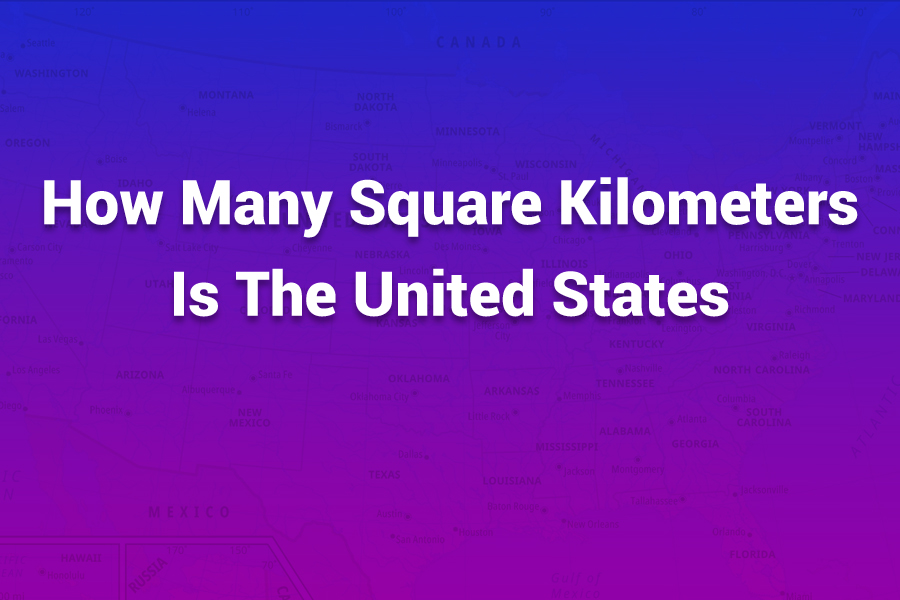The United States spans a vast territory across North America and beyond. But precisely how many square kilometers does it occupy? Understanding the full area requires clarifying whether one includes inland water, coastal zones, or overseas territories.
In this article you will learn the total surface area, the land-only area, distinctions in measurement, comparisons with other countries, and why those numbers matter for geography, policy, and perception.
United States Area Overview
The total area of the United States—including land and inland waters—is approximately 9,831,510 square kilometers. Recent sources confirm that figure has remained stable over time.
Of that total, the land area (excluding lakes, rivers, and wetlands) is about 9,147,420 square kilometers. These two figures are the most commonly accepted metrics for the U.S. footprint.
Why There Are Two Common Figures
Area can be measured differently depending on what is counted:
- Total surface area adds land plus inland water bodies (lakes, rivers, wetlands).
- Land area omits inland water—so it measures only the dry or permanently terrestrial portion.
These definitions lead to slight variance. Also, some sources include or exclude territorial waters (coastal seas) and U.S. territories beyond the 50 states.
Breakdown: Land vs Water
- Land area: ~9,147,420 km²
- Water (inland): about 684,090 km² (the difference between total and land)
Thus roughly 7 % of the U.S. surface is made up of inland water.
How the U.S. Ranks Globally
By land area alone, the U.S. is the third-largest country in the world, behind Russia and China. By total surface area, it also typically ranks third—though in some comparisons China and the U.S. swap places depending on disputed boundaries or coastal inclusion.
Among the largest:
- Russia
- Canada
- United States
- China
But depending on water inclusion, China may edge ahead.
Which States Contribute the Most
The U.S. is a union of 50 states plus Washington, D.C., and various territories. The largest states by area are:
- Alaska (~1,723,337 km²)
- Texas (~696,241 km²)
- California, Montana, New Mexico, etc.
Because Alaska alone accounts for about 18 % of the entire U.S. land, its scale dramatically influences the national total.
Contiguous vs. Continental
Two terms often cause confusion:
- Contiguous U.S. refers to the 48 adjoining states plus D.C.
- Continental U.S. typically includes Alaska (on North America) but excludes Hawaii and overseas territories
The contiguous U.S. covers roughly 8,080,470 km². Alaska adds a huge block, pushing the land total closer to 9.15 million km².
Territories, Coastal Waters & EEZ
The area figures above generally cover only the 50 states plus D.C. They exclude U.S. territories (Puerto Rico, Guam, U.S. Virgin Islands, etc.) and maritime zones.
The U.S. exclusive economic zone (EEZ)—the ocean area over which the U.S. holds special rights—adds another 11,351,000 km². That additional area makes the U.S. reach far beyond land when considering maritime jurisdiction.
Why These Numbers Matter
Geographers, economists, environmental scientists, and policymakers all use area metrics to:
- Compute population density (people per km²)
- Assess resource allocation, land use, and conservation
- Establish boundaries, zones, and jurisdiction
- Compare the U.S. to other nations in scale
For example, using the land figure (~9.15 million km²) and a U.S. population around 340 million (2025 estimate) gives about 37 people per km².
Common Misconceptions to Avoid
- Thinking the U.S. has 10 million km² of land—some older sources round upward—this overestimates by nearly 700,000 km².
- Including ocean area or U.S. EEZ in the “United States’ size” in casual conversation—those territories are maritime, not land.
- Confusing definitions of continental vs contiguous—knowing the difference clears much confusion.
A Visual Comparison
To grasp the scale:
- The U.S. is about 4.5 times larger than Germany in land area.
- It’s nearly the same size as Australia when including both land and water.
- It still trails Russia by a substantial margin.
Recent Stability and Trends
These area figures do not change much over time. Boundaries are stable, and land-water proportions shift only with erosion, flooding, or small reclamation projects. For decades, U.S. land area has hovered between 9,147,000 and 9,161,000 km², with negligible fluctuation.
Which Figure Should You Use?
- Use the 9,831,510 km² total when comparing countries by entire surface size.
- Use 9,147,420 km² land area when doing population density or land resource analysis.
- Always clarify which one you mean.
Conclusion
In summary, the United States covers about 9.83 million square kilometers in total surface area and about 9.15 million square kilometers of land. These figures establish it among the globe’s largest nations in territorial scale.
Including its vast maritime holdings via the EEZ extends U.S. influence well beyond land borders. Whether for academic, demographic, or policy use, these numbers show the real footprint of America.

